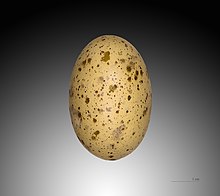Senegal grouse
| Senegal grouse | ||||||||||
|---|---|---|---|---|---|---|---|---|---|---|

Senegal grouse |
||||||||||
| Systematics | ||||||||||
|
||||||||||
| Scientific name | ||||||||||
| Pterocles senegallus | ||||||||||
| ( Linnaeus , 1771) |
The Senegal grouse ( Pterocles senegallus ) is a 33-35 centimeter member of the family of the grouse .
Appearance
The animals have light brown back and stomach plumage. The neck and head are gray, under the eye is a large, light orange spot. The beak and short legs are black. The beak is feathered to prevent sand from entering their lungs. The tail is light brown above and black below, the tip of the tail is fanned out and ends in two black tips. The feathered feet and three broad toes prevent sinking deep into the soft desert sand. The rear toe is small and bony.
distribution and habitat
This species is found in North Africa and Southwest Asia. It inhabits the local deserts and semi-deserts both in the flatlands and on the high plateaus. It also occurs in sparsely overgrown grass steppes.
Way of life
The Senegal grouse lives in colonies of up to 100 individuals. The animals live in monogamy. Since they often have to drink, they are mostly found near smaller watering holes. Their main activity time is the early morning and late afternoon. At lunchtime they look for small bushes to hide from the scorching sun and their predators. At the water holes they usually stand knee-deep in the water and only push their beak briefly into the water, up to ten times in a row. But they are also very fast on the ground. They seek their food for plant seeds on the ground. To be able to digest them better, they swallow small pebbles, which help the stomach to grind the food even more thoroughly. During the day they cover up to 80 kilometers. Their average flight speed is between 20 and 30 km / h, the maximum speed is around 70 km / h. In flight they emit melodic "wittoo-wittoo" sounds. At very high temperatures (over 37 ° C) the activity is restricted. Their natural enemies include foxes, jackals and mongooses.
Reproduction
The reproduction period is variable depending on the area of occurrence. It is April in the Nile Delta and May in the North and Northeast Sahara. The female lays 2–3 yellowish brown eggs with brown and reddish brown spots in a shallow, bare hollow on the ground. The clutch is incubated by both partners. In the nest, the eggs can withstand temperatures of up to 50 ° C for a short time. The female takes over the day shift while the male is responsible for the clutch at night. One partner provides the other with food and water. The young hatch after 23–24 days. Both parents feed them with seeds that have been pre-digested in the parents' crop, and sometimes with smaller insects. The very absorbent breast plumage of the adult birds serves to supply the nestlings with water. The birds settle at a watering hole and hold their belly to the surface of the water. The plumage soaks up the water from there and stores it for the flight back to the nest. The young lick the water from the plumage of the adult bird. The young leave the nest at the age of 4 weeks and are then looked after by both parents until they are fledgled at the age of 2 months. There is only one brood per year. The boys themselves are not sexually mature until they are one year old.
Hazards and protective measures
Since this species is still relatively common and no threats are known, it is classified by the IUCN as ( Least Concern ) not endangered.
literature
- Jiří Felix (eds.), Jaromír Knotek, Libuše Knotková: African fauna in color. Translated from the Czech by Roland Schür. Karl Müller Verlag, Erlangen 1989, pp. 248–249.
- Christopher M. Perrins (Ed.): The FSVO encyclopedia birds of the world. Translated from the English by Einhard Bezzel. BLV, Munich / Vienna / Zurich 2004, ISBN 978-3-405-16682-3 , pp. 284-287 (title of the English original edition: The New Encyclopedia Of Birds. Oxford University Press, Oxford 2003).
Web links
- Pterocles senegallus inthe IUCN Red List of Threatened Species 2017.2. Posted by: BirdLife International, 2016. Retrieved November 17, 2017.
